This post may contain affiliate links. Please read our disclosure policy.
With its simple yet flavorful ingredients, nasi goreng kampung embodies the heart and soul of Malaysian cuisine. It is a versatile dish that can be enjoyed at any time of day.

What is nasi goreng kampung?
Nasi goreng, which translates to “fried rice” in Malaysian or Indonesian languange, is a cornerstone of the nation’s gastronomy. This is a dish that is often seen sold at mamak stalls in Malaysia. In Malaysia, the term “mamak” refers to a type of Indian-Muslim restaurant or eatery, as well as the people who run and frequent these establishments. These eateries are known for serving a variety of Indian and Malaysian dishes, often with a focus on Indian Muslim cuisine. Nasi goreng kampung is also very popular outside of Malaysia, such as in Singapore and Indonesia.
While there are countless variations of this beloved dish, Nasi Goreng Kampung holds a special place in the hearts of many. The term “kampung” means “village” or “countryside,” and it is this rustic quality that sets it apart. Nasi Goreng Kampung is a humble, comforting dish, that evokes the nostalgia of simpler times and rural life.
Basic building blocks of nasi goreng kampung
1. Cooked Rice: The foundation of Nasi Goreng Kampung is steamed rice, preferably day-old rice that has had a chance to firm up. This rice serves as the canvas for the array of flavors that will be added.
2. Aromatic Spices: Shallots, garlic, chili peppers, sambal chili, and sometimes shrimp paste (terasi) are used to create the aromatic base of the dish. These ingredients release their savory fragrance as they sizzle in hot oil.
3. Proteins: While Nasi Goreng Kampung can be made vegetarian, it often features protein sources such as chicken and eggs, which are mostly more accessible and affordable. Most of the time, dried anchovies (ikan teri) are also used to make kampung fried rice
4. Vegetables: Vegetables like carrots, green beans, and water spinach are commonly used in kampung fried rice
5. Seasonings: It uses basic seasonings like salt, sugar, pepper, chicken powder
6. Toppings: Crispy shallots and a fried egg are often used to top off the dish. The egg can be cooked to personal preference, with options ranging from a runny yolk to a fully cooked version.
Nasi Goreng Kampung (Village-style Fried Rice)
Ingredients
- 500 g cooked rice preferably overnight
- 60 g dried anchovies small to medium size
- 3 cups water spinach
- 150 g leftover cooked chicken meat cut into bite-size pieces, see notes
- 3 Tbsp oil or as needed
Aromatics:
- ½ tsp Shrimp paste
- 5 cloves garlic minced or sliced
- 4 shallots thinly sliced
- 5 serrano peppers sliced, more or less to your preference
- 1 Tbsp sambal oelek optional, or any chili sauce of your choice
Seasonings: (please adjust to your taste)
- 1 tsp chicken powder
- ¾ tsp salt or more as needed
- ½ tsp sugar
- ¼ tsp ground white pepper
Instructions
Prepare the rice:
- Keep your leftover rice in the fridge if you plan ahead. They will be nicely dry and perfect to make fried rice
- If you don't have any leftover rice, you can also cook the rice on the same day and spread the rice out on a large baking pan to let it cool down faster. It may take a few hours to cool down completely and to dry them out a bit. Use a fan to help you cool it down if you can
Start cooking:
- Preheat 3 Tbsp of oil in a large pan over medium heat. Add the dried anchovies and pan fry until they are golden brown and crisp. Remove from the oil to an absorbent paper towel
- To the same oil, add shrimp paste and stir fry until fragrant, about a minute or so. Add garlic, shallots, pepper slices, and sambal oelek (if using). Stir fry for another 3 minutes. Add the water spinach and stir fry for about 30 seconds. Add the rice and seasonings. Stir to combine
- Add the cooked chicken meat and stir to combine everything. Make sure the rice is coated evenly with seasonings and mixed well with other ingredients.
- Have a taste and adjust by adding more salt, pepper, salt, etc.
To serve:
- Garnish with some crispy fried shallots (bawang goreng). Serve immediately
RECOMMEDED TOOLS
Marv’s Recipe Notes
*Nutrition facts are just estimates and calculated using online tools*

How to cook nasi goreng kampung
1. Leftover cooked rice is the best to make good fried rice. You want a dry texture of the rice. If you don’t have any cooked rice and want to make some, you can look at this how to cook jasmine rice (or any white long-grain rice)
2. Preheat 3 Tbsp of oil in a large pan over medium heat. Add the dried anchovies and pan fry until they are golden brown and crisp. Remove from the oil to an absorbent paper towel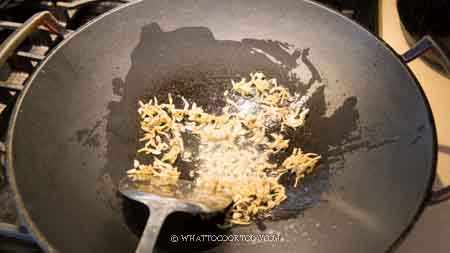
3. To the same oil, add shrimp paste and stir fry until fragrant, about a minute or so. If you want to add raw meat (like chicken or beef, etc) add it here and cook until they are opaque and cooked through. Remove the meat and set aside. Then add garlic, shallots, pepper slices, sambal oelek if using.Add another tablespoon of oil if needed. Stir fry for another 3 minutes. 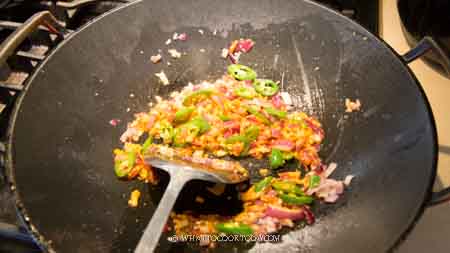
4. Add the water spinach and stir fry for about 30 seconds. 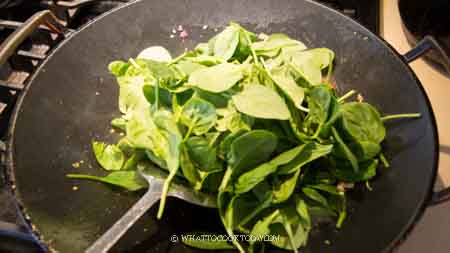
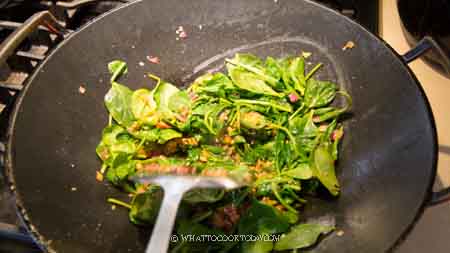
5. Add the rice and seasonings. Stir to combine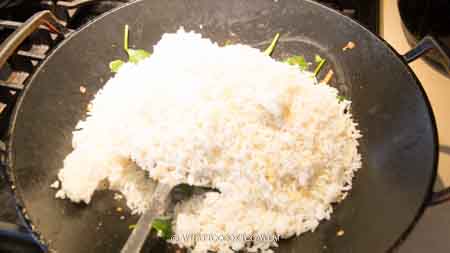
6. Add the cooked chicken meat and stir to combine everything. Make sure the rice is coated evenly with seasonings and mixed well with other ingredients.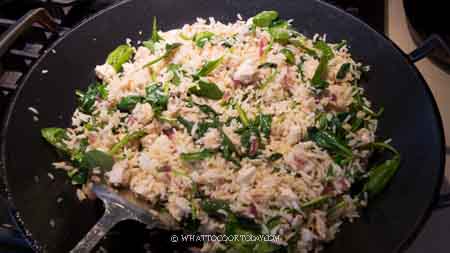
7. Have a taste and adjust by adding more salt, pepper, salt, etc.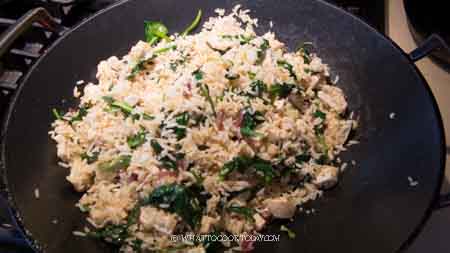
8. Garnish with the fried anchovies, and some crispy fried shallots (bawang goreng) and serve immediately

Did you make this nasi goreng kampung recipe?
I love it when you guys snap a photo and tag it to show me what you’ve made. Simply tag me @WhatToCookToday #WhatToCookToday on Instagram and I’ll be sure to stop by and take a peek for real!



2 comments
Hello there. As a Malaysian I would say you got almost everything correct except that we don’t use sambal olek in nasi goreng kampung. Shrimp paste and anchovies, yes we use them, hence the name kampung because it’s rustic cooking, but we call the former as belacan and anchovies as ikan bilis.
Hi Nora, thank you for sharing your knowledge! Yes, I know sambal oelek is more Indonesian actually lol! it’s hard to find fresh red chili here so that’s why I put in sambal oelek, which is strangely widely available here.